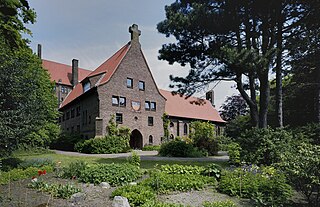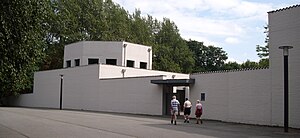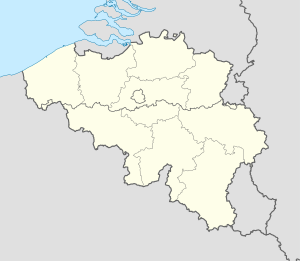
Sint-Niklaas is a Belgian city and municipality located in the Flemish province of East Flanders. The municipality comprises the city of Sint-Niklaas proper and the towns of Belsele, Nieuwkerken-Waas, and Sinaai.
A canoness is a member of a religious community of women living a simple life. Many communities observe the monastic Rule of St. Augustine. The name corresponds to the male equivalent, a canon, though some women may use the title canon and not canoness similar to the way actor is used rather than actress, e.g. Sarah Foot. The origin and Rule are common to both. As with the canons, there are two types: canonesses regular, who follow the Augustinian Rule, and secular canonesses, who follow no monastic Rule of Life.

Susteren Abbey is a former Benedictine abbey at Susteren near Roermond, in the Dutch province of Limburg, founded in the 8th century. The former abbey church is now St. Amelberga's Basilica.

Gandersheim Abbey is a former house of secular canonesses (Frauenstift) in the present town of Bad Gandersheim in Lower Saxony, Germany. It was founded in 852 by Duke Liudolf of Saxony, progenitor of the Liudolfing or Ottonian dynasty, whose rich endowments ensured its stability and prosperity.

Beatrice I, also known as Beatrice of Franconia, was Abbess of Gandersheim Abbey from 1043 and Princess-Abbess of Quedlinburg Abbey from 1044 until her death.

Egmond Abbey or St. Adalbert's Abbey is a Benedictine monastery of the Congregation of the Annunciation, situated in Egmond-Binnen, in the municipality of Bergen, in the Dutch province of North Holland. Founded in 920-925, and destroyed during the Reformation, it was re-founded in 1935 as the present Sint-Adelbertabdij, in the Diocese of Haarlem.

Herkenrode Abbey was a Catholic monastery of Cistercian nuns located in Kuringen, part of the municipality of Hasselt, which lies in the province of Limburg, Belgium.

Forest Abbey or Vorst Abbey was a Benedictine abbey located in the Brussels municipality of Forest, Belgium. It was founded in 1105 and existed for nearly 700 years, until its partial destruction by fire in 1764. It was abolished in 1796. Only the abbey's 18th-century outbuildings have been preserved. They are now owned by the municipality and serve as a cultural centre.

The Abbey of the Holy Cross was a French Benedictine monastery of nuns founded in the 6th century. Destroyed during the French Revolution, a new monastery with the same name was built in a nearby location during the 19th century for a community of Canonesses of St. Augustine of the Mercy of Jesus.

Ten Putte Abbey is a monastery with an abbey in Gistel, roughly 8 km to the south of Ostend, in the western part of Belgium. It was built to mark the spot where, in 1070, Saint Godelina was murdered by strangulation and then thrown into a pond. Before 2007 the abbey was home to nine Benedictine nuns, who were members of the wider Subiaco Cassinese Congregation in West Flanders. Since 2007 it has been occupied by brothers and sisters of the "Mother of Peace" community.

Drongen Abbey, or the Old Abbey, Drongen, is a monastic complex on the River Leie in Drongen, a part of the city of Ghent in East Flanders, Belgium.

Male Castle, Bruges. A community of the Canonesses Regular of the Holy Sepulchre. It originated in Bruges in the 11th century, and between 1954 and 2013 was settled in Male Castle in Male, Sint-Kruis, Bruges, West Flanders, Belgium.
The Abbey of Onze-Lieve-Vrouw ter Nieuwe Plant, formerly also Roesbrugge Abbey is a community of Augustinian canonesses belonging to the Congregation of Windesheim. The sisters are informally known as the Roesbrugge Dames - the Roesbrugge Ladies. Located in Roesbrugge from 1239 to the late 16th century, the community then moved into Ypres, West Flanders, Belgium, where it exists today. Its adjacent school is the Lyceum Onze Lieve Vrouw ter Nieuwe Plant.

Nivelles Abbey is a former Imperial Abbey of the Holy Roman Empire founded in 640. It is located in Nivelles, Walloon Brabant, Belgium.

Ten Duinen Abbey or the Abbey of the Dunes was a Cistercian monastery at Koksijde in what is now Belgium. It was one of the richest and most influential religious institutions in the medieval County of Flanders. It later relocated from Koksijde to the city of Bruges.

Oosteeklo Abbey was a Cistercian nunnery founded in Oosteeklo in 1217 and later moved to Ghent.

Rijnsburg Abbey was a Benedictine nunnery in Rijnsburg, Netherlands, active between 1133 until 1574.
The Vilich Abbey is a former monastery located in North Rhine-Westphalia. It is named after the canonized Adelaide of Vilich, who lived from 970 to 1015. After her death, a cult formed around her and the convent. The convent was terminated in 1804 due to secularization. It was destroyed during the Thirty Years´ war and rebuilt. The Franciscans took over the abbey as a hospital in 1865, followed by many different charitable institutions. The church was destroyed in World War II and once again restored, and is now used as a retirement home.

Dendermonde Abbey or the Abbey of Saints Peter and Paul is a Benedictine monastery in Dendermonde (Belgium), which played a role in the Liturgical Movement in Belgium.



















